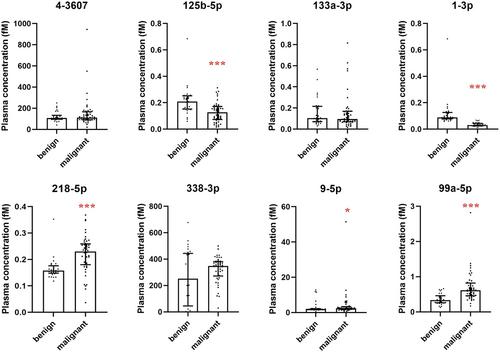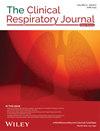With wide application of computed tomography (CT) in early lung cancer screening, solitary pulmonary nodules (SPNs) are frequently detected. Due to their high etiological diversity and potential for malignancy, rapid and accurate identification and malignant SPNs are crucial in the clinical management. In the present study, plasma exosomal microRNAs were identified and evaluated as sensitive and specific indicators for malignant SPNs.
Exosomal miRNAs isolated from the plasmas of pathologically confirmed patients with SPN (four malignant and four benign, designated as the screening set) were subjected for high throughput sequencing and eight candidate miRNAs were selected. The pre-operation plasma levels of the candidate miRNAs in 77 patients with SPN (48 malignant and 29 benign, designated as the identification set) were detected by quantitative PCR, five miRNAs were identified as potential biomarkers for malignant SPNs, and the diagnostic values of the five miRNAs each alone or combined were then analyzed by AUROC analysis. The prediction values of the identified miRNAs were further evaluated in 95 patients with SPN (double blind, 74 malignant and 21 benign, designated as the validation set).
High-throughput sequencing identified 45 miRNAs with statistical differences between benign and malignant SPNs. Among the eight candidate miRNAs in the identification set, miR-1-3p alone had the best diagnostic value, with the sensitivities and specificities of 89.6% and 100% for malignant SPNs. Unexpectedly, when miR-1-3p was combined with miR-99a-5p, both the sensitivity and specificity reached 100% for malignant SPNs. miR-1-3p+miR-125b-5p and miR-1-3p+miR-218-5p were also good indicators of malignant SPNs with sensitivities of 95.8% and 97.9%, specificities of 100% and 96.6%. Further analysis of these microRNA combinations in the validation set indicated that the PPV were 91.4%, 97.4%, and 93.5% and the NPV were 100%, 100%, and 88.9% for miR-1-3p+miR-99a-5p, miR-1-3p+miR-218-5p, and miR-1-3p+miR-125b-5p, with the sensitivities were 100%, 100%, and 97.3% and the specificities were 66.7%, 90.5%, and 76.2% for miR-1-3p+miR-99a-5p, miR-1-3p+miR-218-5p, and miR-1-3p+miR-125b-5p, respectively.
Through high throughput sequencing, qPCR determination of plasma microRNAs and AUROC analysis, miR-1-3p combined with miR-99a-5p, miR-125b-5p, or miR-218-5p have been found to be sensitive and specific indicators of malignant SPNs in both the identification and validation sets. Our results indicate that the panels of plasma miRNAs can be used as diagnostic biomarkers for malignant SPNs.



